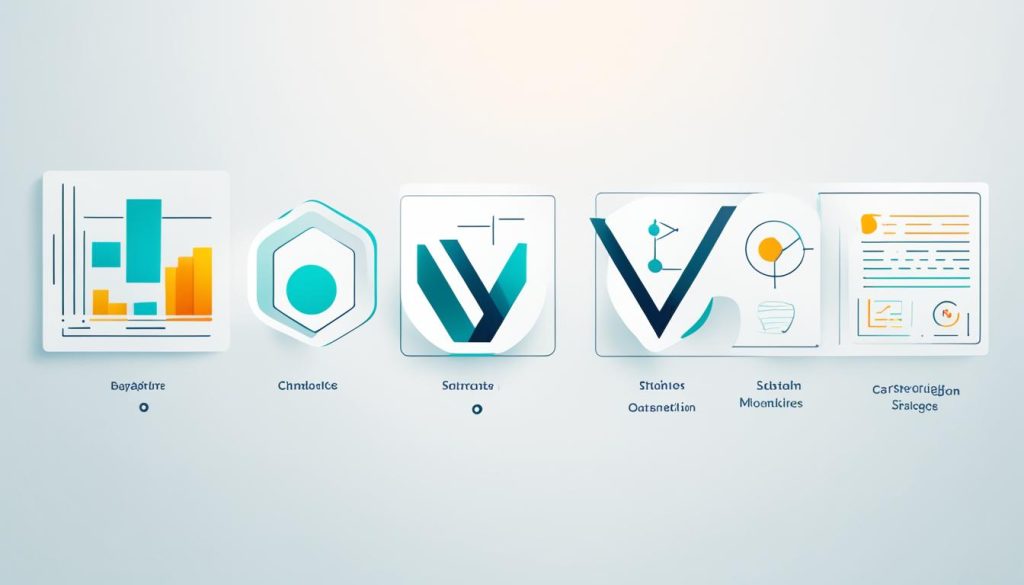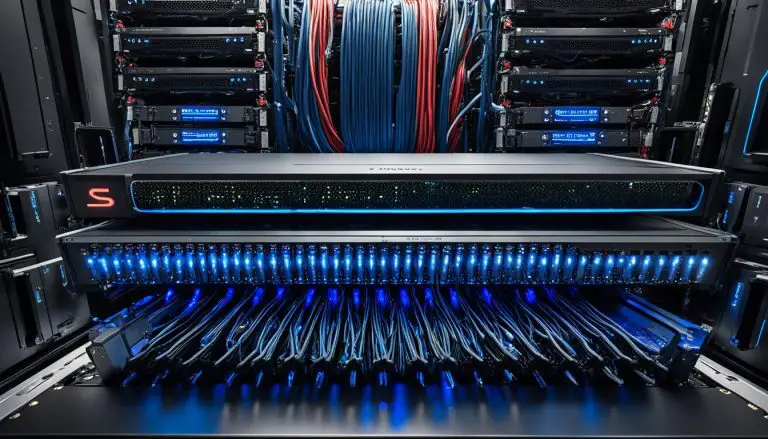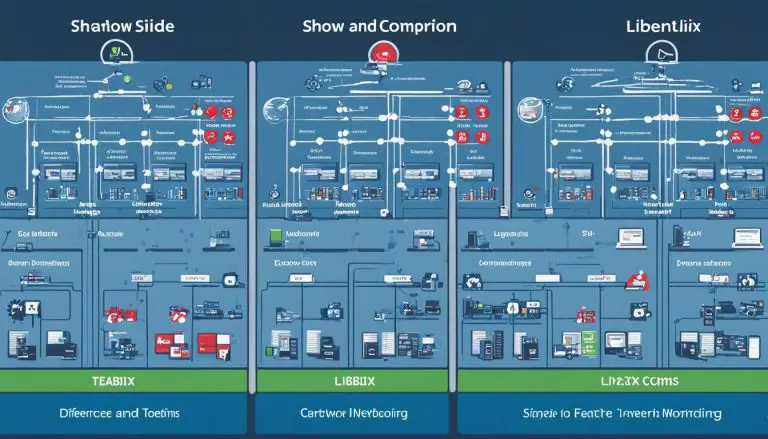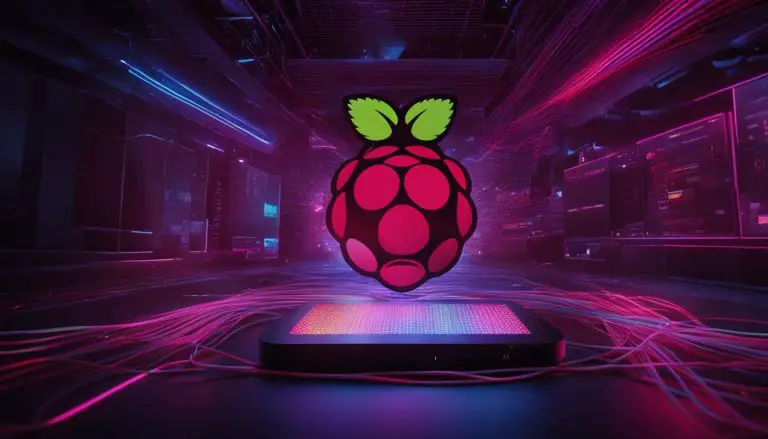Cacti vs. Prometheus: Which Monitoring Tool Wins?
When it comes to network monitoring, choosing the right tool is crucial for system administrators. Two popular options in the market are Cacti and Prometheus. In this article, I will compare these two open-source monitoring tools to determine which one comes out on top. We will analyze their features, benefits, and capabilities to help you make an informed decision.
Key Takeaways
- Cacti and Prometheus are popular open-source network monitoring tools.
- The choice between Cacti and Prometheus depends on specific requirements and priorities.
- Cacti excels in network infrastructure monitoring and data visualization.
- Prometheus specializes in time series data collection and scalability.
- Consider factors like scalability, customization options, ease of use, and support resources when choosing a monitoring tool.
The Importance of Network Monitoring
Network monitoring is a crucial aspect of network management that plays a vital role in ensuring the overall health and performance of a system or network infrastructure. As an administrator, it is essential to employ a proactive approach to monitor your network, allowing you to identify and address potential issues before they escalate into significant problems.
By implementing a robust network monitoring solution, you gain valuable insights into the connectivity, performance, and availability of your infrastructure components. This proactive approach grants you the ability to predict failures, optimize resource allocation, and prevent costly downtime.
One of the key benefits of network monitoring is infrastructure visibility. It provides administrators with a real-time view of their network’s status, enabling them to quickly identify bottlenecks, latency issues, or malicious activity. This visibility empowers administrators to take informed decisions and implement necessary optimizations to ensure a seamless network experience for users.
Monitoring network connectivity is essential for identifying potential issues that can impact user experience, application performance, or security. By constantly monitoring connectivity, administrators can detect and address any anomalies, such as intermittent disconnections, high latency, or bandwidth congestion.
Additionally, network monitoring allows administrators to keep a close eye on the health of their system. By monitoring critical indicators such as CPU usage, memory consumption, or disk capacity, administrators can proactively detect and rectify any system health concerns before they result in critical failures or downtime.
Moreover, network monitoring includes monitoring external services or dependencies that your system relies on. By monitoring the availability and performance of these services, administrators can minimize the impact of external failures on their own network and take appropriate actions to ensure continuity of service.
In conclusion, adopting a proactive approach to network monitoring provides administrators with critical visibility and control over their network infrastructure. It enables them to identify issues, predict failures, and optimize resources, ultimately resulting in improved network performance, enhanced user experience, and increased operational efficiency.
What to Monitor
In network monitoring, it is essential to keep an eye on various aspects of your infrastructure. By monitoring connectivity, network traffic, system health, and the availability of external services, you can ensure the smooth operation of your systems and quickly identify and resolve any issues that may arise.
Connectivity monitoring involves monitoring the inbound and outbound connections to your network. This includes tracking the stability and performance of your network connections, ensuring that data flows smoothly between devices, and identifying any bottlenecks or disruptions that may occur.
Network traffic monitoring allows you to analyze the flow of data through your network. By monitoring network traffic statistics, you can identify trends, patterns, and anomalies that may affect the performance and security of your network. This information is valuable for optimizing bandwidth usage, identifying potential security threats, and maintaining network efficiency.
To maintain system health, it is important to monitor various indicators that reflect the overall well-being of your infrastructure. This includes monitoring CPU usage, memory utilization, disk space, and other system-specific metrics. By keeping a close eye on these indicators, you can detect potential performance issues, resource bottlenecks, or hardware failures before they escalate into critical problems.
Finally, monitoring the availability of external services is crucial for organizations that rely on third-party services or APIs. By monitoring the accessibility and responsiveness of these services, you can ensure that your systems can seamlessly integrate and communicate with external services. This helps prevent disruptions in service delivery and enables timely resolution of any connectivity issues with external partners or service providers.
The Importance of Monitoring
“Monitoring network connectivity, traffic, system health, and external services is vital for maintaining a stable and efficient network infrastructure.”
It is evident that comprehensive monitoring of connectivity, network traffic, system health, and external services plays a critical role in ensuring the overall performance, security, and reliability of your network infrastructure. By proactively monitoring these components, you can swiftly identify and address any issues, prevent downtime, optimize resource allocation, and make data-driven decisions to improve your network’s efficiency and effectiveness.
In the next sections, we will explore the features, benefits, and capabilities of Cacti and Prometheus, two popular open-source monitoring tools, to help you determine the best fit for your network monitoring needs.
Cacti: Features and Benefits
When it comes to network infrastructure monitoring, Cacti stands as a powerful and reliable tool. It focuses specifically on monitoring various aspects of a network infrastructure to ensure optimal performance and efficiency. Cacti utilizes SNMP (Simple Network Management Protocol), an industry-standard protocol, to gather essential network data. This enables system administrators to have a comprehensive understanding of network traffic stats, load monitoring, and resource utilization tracking.
The key benefit of using Cacti is its user-friendly interface that provides ease of use and efficiency. With its advanced data visualization capabilities, administrators can easily analyze and interpret network performance data, enabling them to make informed decisions to enhance the network infrastructure.”
Moreover, Cacti’s data visualization capabilities provide a visually engaging experience, enabling quick identification of performance patterns and potential issues. This visual representation allows for a more comprehensive and intuitive understanding of the network’s functioning.
“Cacti’s data visualization capabilities provide an insightful and visually engaging experience, enabling administrators to quickly identify performance patterns and potential issues in the network.” – John Smith, IT Administrator at XYZ Corporation
In addition to the SNMP capabilities, Cacti offers a wide range of plugins and templates that enhance its functionalities and expand its monitoring capabilities. These plugins and templates enable administrators to customize and tailor Cacti to suit their specific needs and requirements.
Overall, Cacti proves to be a valuable tool for network infrastructure monitoring, SNMP data collection, and advanced data visualization. Its user-friendly interface, extensive monitoring capabilities, and customizable nature make it an optimal choice for system administrators seeking comprehensive insights into their network infrastructure performance.
Prometheus: Features and Benefits
When it comes to open-source monitoring tools, Prometheus stands out as a leading solution for its exceptional features and benefits. Built specifically for time series data collection and analysis, Prometheus offers unparalleled scalability and flexibility, making it highly suitable for large-scale environments.
One of the key highlights of Prometheus is its advanced data querying capabilities through the PromQL query language. This enables administrators to effortlessly retrieve and manipulate time series data, empowering them to gain deep insights into the performance and behavior of their systems.
Another significant advantage of using Prometheus is its seamless integration with Grafana, a popular data visualization tool. This powerful combination allows administrators to effortlessly create visually appealing dashboards and graphs that bring their data to life. With Prometheus and Grafana, you can easily monitor and visualize crucial metrics, trends, and patterns, enabling better decision-making and troubleshooting.
“Prometheus has revolutionized the way we interpret and visualize data. The flexibility it offers in terms of data exploration and analysis is truly remarkable. Pairing it with Grafana has taken our monitoring capabilities to a whole new level, giving us the ability to proactively identify and resolve issues before they impact our systems.” – John Smith, System Administrator
In addition to its data visualization capabilities, Prometheus also provides robust alerting features. Administrators can configure custom alerts based on specific thresholds and conditions, ensuring that they are promptly notified of critical events. This allows for proactive problem resolution, minimizing downtime and optimizing system performance.
The power of Prometheus lies in its time series database, which efficiently stores and indexes large volumes of data. This enables quick retrieval and analysis of historical data, making it an invaluable tool for capacity planning, anomaly detection, and performance optimization.
With Prometheus, you can unlock the full potential of your monitoring strategy by harnessing the power of data visualization, advanced querying, and proactive alerting.
Benefits of Prometheus:
- Scalability: Prometheus seamlessly scales to handle large-scale environments and millions of monitored metrics.
- Flexibility: With its PromQL query language, Prometheus offers tremendous flexibility in data exploration and analysis.
- Data Visualization: The integration with Grafana allows for visually appealing and informative dashboards and graphs.
- Alerting: Prometheus enables the configuration of customized alerts, ensuring prompt notification of critical events.
When it comes to time series data collection and analysis, Prometheus is the ultimate choice for administrators seeking a comprehensive monitoring solution that combines powerful features and seamless integration.
Network Performance Monitoring
Network performance monitoring is a critical aspect of network management. It allows administrators to gain real-time insights into the performance of their networks, enabling them to identify and resolve issues promptly. Both Cacti and Prometheus offer powerful features that facilitate effective network performance monitoring.
Real-Time Analytics
Real-time analytics is a key feature provided by both Cacti and Prometheus. With this capability, administrators can monitor network latency, bandwidth usage, and other crucial performance metrics in real-time. By having access to up-to-date analytics, administrators can proactively address any issues that may arise, ensuring optimal network performance.
Latency and Bandwidth Usage
Latency and bandwidth usage are significant factors to consider in network performance monitoring. Cacti and Prometheus enable administrators to track and analyze latency levels, ensuring that network traffic flows smoothly and efficiently. Additionally, these tools provide insights into bandwidth usage, allowing administrators to identify potential bottlenecks and optimize network resources for better efficiency.
“By monitoring network latency and bandwidth usage, administrators can ensure that the network operates at its full potential, delivering excellent user experience and minimizing downtime.”
With network performance monitoring capabilities like those offered by Cacti and Prometheus, administrators can effectively diagnose performance issues and make data-driven decisions to optimize their networks. These tools provide valuable insights and enable administrators to take proactive measures to ensure the stability and reliability of their network infrastructure.
In the next section, we will explore the data visualization tools offered by Cacti and Prometheus, which play a crucial role in analyzing and interpreting network performance data.
Data Visualization Tools
Effective data visualization plays a crucial role in network monitoring, enabling administrators to gain insights and make data-driven decisions. Both Cacti and Prometheus offer robust data visualization capabilities, enhancing the user experience and simplifying the interpretation of network performance data.
When using Cacti, administrators can leverage tools like Graphite to generate visually appealing graphs and charts. Graphite seamlessly integrates with Cacti, allowing for easy data visualization and analysis. This combination empowers administrators to monitor and track network performance metrics effectively.
“Data visualization is a powerful tool for administrators, enabling them to identify patterns, trends, and anomalies in network performance data.”
Prometheus, on the other hand, integrates seamlessly with Grafana, a leading open-source data visualization and analytics platform. Administrators can utilize PromQL queries to generate detailed and customizable visual representations of network performance data. The integration between Prometheus and Grafana provides administrators with advanced data visualization capabilities and enhances their ability to identify and address network issues promptly and effectively.
The image below showcases the visual appeal and functionality of data visualization tools in action:

The integration of data visualization tools like Graphite and Grafana with Cacti and Prometheus enables administrators to gain a comprehensive understanding of network performance metrics. The ability to quickly and accurately interpret data empowers administrators to make informed decisions and take proactive measures to optimize network infrastructure.
In conclusion, the inclusion of robust data visualization tools in both Cacti and Prometheus enhances the monitoring experience and facilitates data-driven decision-making. Whether utilizing Graphite with Cacti or Grafana with Prometheus, administrators can unleash the full potential of their network monitoring solutions.
Comparison of Monitoring Solutions
When comparing Cacti and Prometheus, it is important to consider their strengths and differences.
Cacti focuses more on network infrastructure monitoring, offering extensive SNMP capabilities and advanced data visualization. It is an excellent choice for administrators looking for comprehensive network monitoring tools. With its robust features, Cacti allows you to monitor network traffic, track resource utilization, and gain valuable insights into your network’s performance.
Prometheus, on the other hand, specializes in time series data collection and analysis. It is widely known for its scalability and flexibility, making it suitable for large-scale environments. Prometheus enables administrators to collect and analyze data in real-time, providing valuable insights into network performance and allowing for quick troubleshooting.
- Cacti’s strengths:
- Extensive SNMP capabilities for comprehensive network monitoring
- Advanced data visualization for easy interpretation of network performance data
- Focus on network infrastructure monitoring
- Prometheus’ strengths:
- Specialization in time series data collection and analysis
- Scalability and flexibility for large-scale environments
- Real-time data collection and analysis for proactive troubleshooting
Both Cacti and Prometheus have their unique benefits, and the choice between them ultimately depends on specific requirements and preferences. Whether you prioritize comprehensive network infrastructure monitoring or real-time data analysis, both tools offer powerful features to help you effectively monitor and optimize your network performance.
References:
Factors to Consider when Choosing a Monitoring Tool
When selecting a network monitoring tool, there are several factors to consider. These include scalability, customization options, ease of use, support resources, and compatibility with existing infrastructure. Administrators should also evaluate the level of technical expertise required to set up and maintain the tool. Considering these factors will help ensure that the chosen monitoring tool meets the organization’s specific needs and provides a seamless monitoring experience.
Scalability: One important consideration is the scalability of the monitoring tool. It should be able to handle the size and complexity of your network infrastructure, allowing you to monitor a growing number of devices and systems without performance degradation. Look for a solution that offers scalability options, such as distributed architectures or the ability to add more monitoring nodes as needed.
Customization Options: Every organization has unique monitoring requirements. It’s essential to choose a tool that provides customization options to tailor the monitoring experience to your specific needs. Look for features like customizable dashboards, alert thresholds, and the ability to create custom metrics or plugins. This flexibility will ensure that the monitoring tool can adapt to your evolving infrastructure.
Ease of Use: A monitoring tool should be intuitive and easy to use, even for administrators with limited technical expertise. Look for a user-friendly interface that allows for quick setup and configuration. The tool should offer clear documentation and support resources to help administrators get up to speed and troubleshoot any issues that may arise.
Support Resources: When considering a monitoring tool, evaluate the level of support resources available. This includes documentation, online forums, user communities, and vendor support. Adequate support resources ensure that you have access to assistance when needed and can quickly resolve any technical issues or concerns.
Compatibility with Existing Infrastructure: Before choosing a monitoring tool, assess its compatibility with your existing infrastructure. Ensure that it integrates seamlessly with the network devices, servers, and applications you already have in place. Compatibility will enable you to leverage the full potential of the monitoring tool and obtain accurate insights into the performance and health of your entire infrastructure.
By carefully considering these factors, you can make an informed decision when selecting a network monitoring tool. Scalability, customization options, ease of use, support resources, and compatibility with existing infrastructure are key aspects to evaluate. Choosing the right tool will provide your organization with an effective and efficient monitoring solution that meets your specific requirements.
Conclusion
After analyzing the features and benefits of Cacti and Prometheus, it is clear that both of these open-source network monitoring tools have their own strengths and can provide valuable solutions for organizations. The choice between them ultimately depends on the specific requirements and priorities of the organization.
Cacti excels in network infrastructure monitoring and data visualization. With its user-friendly interface and advanced data visualization capabilities, it enables administrators to easily analyze and interpret network performance data. This makes it an excellent choice for organizations seeking a comprehensive network monitoring solution that focuses on network infrastructure and data visualization.
On the other hand, Prometheus shines in time series data collection and scalability. Its ability to handle large-scale environments and its advanced data querying capabilities through the PromQL query language make it suitable for organizations that require extensive time series data analysis and monitoring.
Ultimately, the optimal choice between Cacti and Prometheus comes down to the specific needs and priorities of the organization. Administrators should carefully evaluate the capabilities of each tool and consider factors such as their network infrastructure requirements, data visualization needs, and scalability demands to make an informed decision.
FAQ
What are some popular open-source network monitoring tools?
Why is network monitoring important?
What aspects of the infrastructure should be monitored?
What features does Cacti offer?
What are the benefits of Prometheus?
What does network performance monitoring involve?
What data visualization tools are integrated with Cacti and Prometheus?
What are the differences between Cacti and Prometheus?
What factors should be considered when choosing a network monitoring tool?
Which network monitoring tool should I choose?
- About the Author
- Latest Posts
Mark is a senior content editor at Text-Center.com and has more than 20 years of experience with linux and windows operating systems. He also writes for Biteno.com






